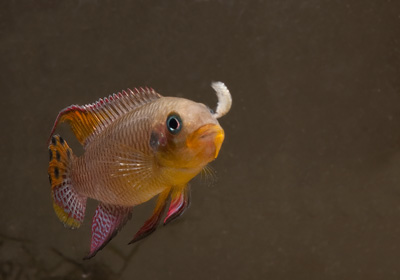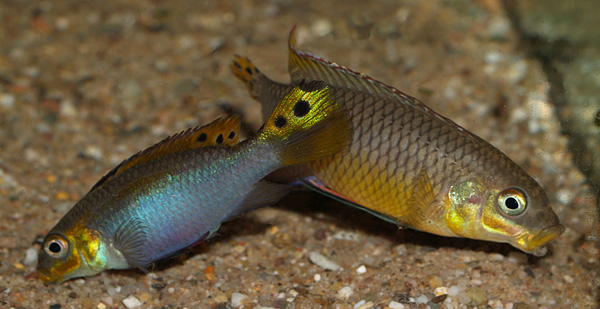NIR vision helps fish hunt and mate
Submitted by ianm on 2 November 2012 - 11:27am
Biologists from the University of Bonn, Germany, have discovered that the cichlid fish Pelvicachromis taeniatus can see in the NIR; this was thought to be unlikely until now. This NIR vision is thought to help fish to hunt in shallow African rivers. The results are being published in Naturwissenschaften (doi: 10.1007/s00114-012-0980-7).
A research team in the work group of Professor Dr T.C.M. Bakker at the Institute for Evolutionary Biology and Ecology, University of Bonn, has been studying the biology of the African cichlid fish Pelvicachromis taeniatus for years. His team investigated the ability to see in the NIR using a classical prey choice experiment. P. taeniatus feeds on small crustaceans, such as freshwater shrimp. These prey animals reflect NIR radiation. In a dark room a prey selection experiment was set up illuminated by infrared lamps. In front of the tank containing the fish, freshwater shrimp were offered in two separate chambers. One of the chambers was covered with a filter blocking NIR wavelengths. The other chamber was covered with a filter that would let only NIR light pass. “Consequently, the fish were only able to perceive the freshwater shrimp in one chamber in the near infrared range”, explains Dr Sebastian Baldauf, one of the scientists involved in the study.

The experiment showed that the fish spent more time and were more frequently in front of the chamber that let NIR light pass. “The fish detect their prey based on infrared radiation alone. Until now, physiologists thought that noise levels in the near infrared range were too high to allow visual perception.” As the experiment has shown, the fish were capable of perceiving prey in a wavelength range above 780 nm. It is well-known that snakes can perceive far infrared radiation at longer wavelengths, above 2000 nm. “But they don't use their eyes for this purpose; instead they have a heat-sensitive pit organ,” says Dr Baldauf. Human eyes are not capable of seeing infrared radiation.
The advantage of the fish’s ability to see infrared may become obvious when you look at its natural habitat. The shallow rivers of West Africa have a relatively large amount of infrared radiation. “That’s exactly why it makes sense to use infrared cues for detecting prey organisms,” explains Dr Baldauf. “It is a clear selective advantage if you can perceive additional signals that others cannot perceive.” It is quite likely that other animals also have evolved a perception of NIR radiation, e.g. for hunting or orientation, such as other fishes or birds. The researchers from the University of Bonn now want to study more closely the physiology of infrared vision, and to what extent infrared radiation is relevant in other contexts.
When performing colour measurements on these fish the researchers found that certain regions of the cichlid body reflect the light in the NIR range. “We found that females reflect infrared radiation from their belly region, and males from their fins”, says Dr Baldauf. The female belly is important for mate choice, and the fins are displayed during aggressive encounters between males. “Perhaps near infrared signals play a role in visual communication in this species”, he says. “And that’s what we additionally would like to study in further experiments.”
